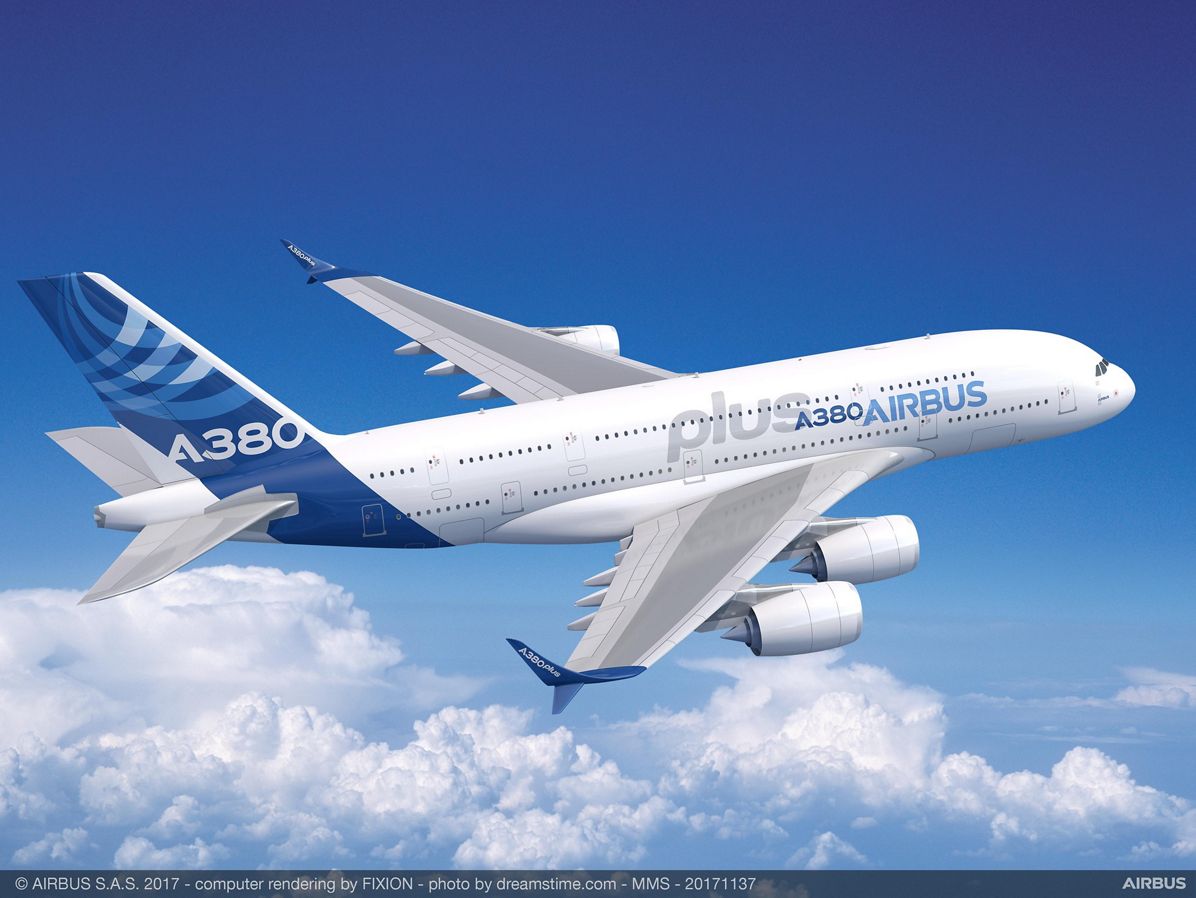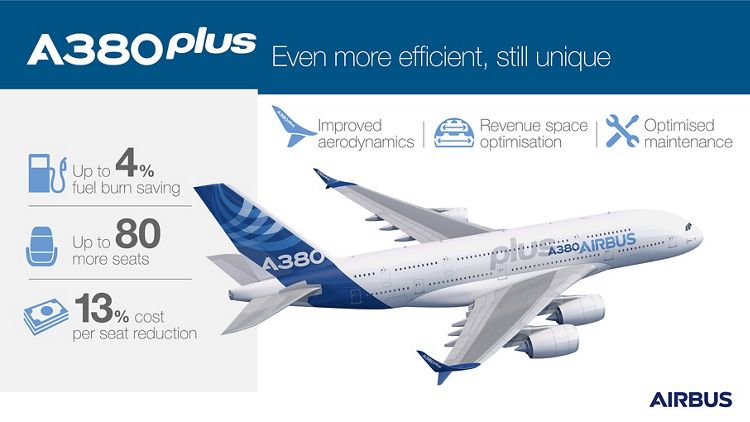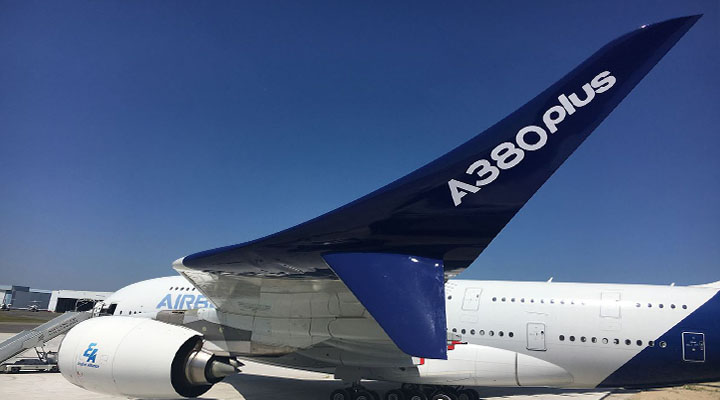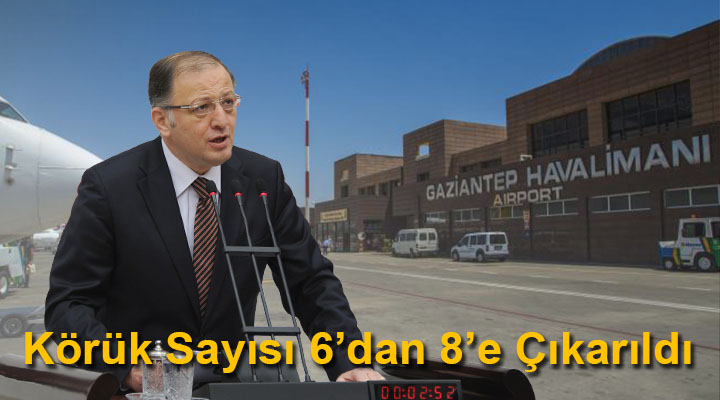Airbus is presenting a development study for an enhanced A380, the “A380plus”. The study includes aerodynamic improvements in particular new, large winglets and other wing refinements that allow for up to 4% fuel burn savings.
Added to an optimised A380 maintenance programme and the enhanced cabin features first shown at Aircraft Interiors Expo (AIX) in April, the overall benefit is a 13% cost per seat reduction versus today’s A380.
John Leahy, Airbus COO Customers, explains: “The A380plus is an efficient way to offer even better economics and improved operational performance at the same time.” John adds: “It is a new step for our iconic aircraft to best serve worldwide fast-growing traffic and the evolving needs of the A380 customers. The A380 is well-proven as the solution to increasing congestion at large airports, and in offering a unique, passenger-preferred experience. ”
The new winglets measure approximately 4,7 metres in height (an uplet of 3.5m, and a downlet of 1,2m). It is designed to improve aerodynamics and reduce drag.
The optimised cabin layout based on the ‘cabin enablers’ presented at Aircraft Interiors Expo (AIX), allows up to 80 additional seats* with no compromise on comfort: redesigned stairs, a combined crew-rest compartment, sidewall stowage removal, a new 9-abreast seat configuration in premium economy and 11-abreast in economy.

The A380plus will have an increased maximum take-off weight (MTOW) of 578 tonnes providing the flexibility of carrying up to 80 more passengers over today’s range (8,200nm), or flying 300nm further.
The A380plus features longer maintenance check intervals, a reduced six-year check downtime, and systems improvements, which will reduce maintenance costs and increase aircraft availability.
The A380 is the world’s largest, most spacious airliner that offers passengers the smoothest, quietest and most comfortable ride. With two full widebody decks, offering widest seats, wide aisles and more floor space, the A380 has the unique capability to generate revenue, stimulate traffic and attract the flying public, who can now specifically select the A380 when booking a flight via the iflyA380.com web site. Over 170 million passengers have already enjoyed the experience of flying on board an A380 today. Every two minutes, an A380 takes off or lands somewhere in the world.
*Note for Editors:
497 passengers is the airline’s average capacity of the A380s currently in operation today – which are consistently attracting above-average passenger load factors. With all A380 cabin enablers, the A380 average seat count would move from 497 to 575 in four classes, and generate significantly more revenue for airlines.

Cabin enablers description
New Forward Stairs – 20 more passengers (Business, Premium Economy & Economy Classes)
The NFS involves relocation of the forward stair from Door 1 to Door 2, and combining the entrance of the NFS to the upper deck (going up), with the adjacent staircase to the lower-deck crew-rest (going down). The NFS would make room for up to 20 additional passengers.
Combined Crew-Rest Compartment (CCRC) – three more passengers (Premium Economy)
For the CCRC, the existing flight-crew-rest (behind the cockpit in the mezzanine area at Door 1) is moved down and combined with the cabin crew rest on the lower deck. This innovation frees space for three extra Premium-Economy passengers at the front of the main-deck.
11-abreast 3-5-3 economy layout on the main-deck – 23 more passengers (Economy Class)
Thanks to an innovative seating concept developed by Airbus and its seating partners, Airbus is able to maintain an 18inch seat-width while offering airlines an 11-abreast Economy Class on the main-deck in a ‘3-5-3’ configuration. This enables an increase in capacity of 23 seats – adding significantly to the A380’s revenue-generating potential.
New Aft-Galley Stair Module (AGSM) – 14 more passengers + two food trolleys
The AGSM involves the redesign of the rear-stair from a spiral configuration to a straight/square one. On the main-deck, this allows valuable storage volume for galley modules. Overall the AGSM provides space for 14 more revenue passengers plus two extra food trolleys.
Upper-deck sidewall stowage removal – 10 more passengers (Business Class)
The option to remove the sidewall stowages on the upper-deck increases the wall-to-wall cabin width at foot-rest height – which makes space for up to 10 more business class seats / beds when an angled herring-bone arrangement is used.
Nine-abreast Premium Economy on the main deck – 11 more passengers (Premium Economy)
The A380’s generous main-deck cross section – significantly wider than any other commercial airliner – is allowing seat manufacturers to optimise their Premium Economy (PE) seat designs to create the industry’s most efficient and comfortable PE layout possible. This layout enables 11 more PE seats than in an eight-abreast layout.






